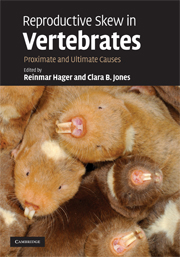Book contents
- Frontmatter
- Contents
- List of contributors
- Foreword
- Preface
- Part I Reproductive skew theory
- Part II Testing assumptions and predictions of skew models
- 3 Reproductive skew in female-dominated mammalian societies
- 4 The effects of heterogeneous regimes on reproductive skew in eutherian mammals
- 5 Social skew as a measure of the costs and benefits of group living in marmots
- 6 Explaining variation in reproductive skew among male langurs: effects of future mating prospects and ecological factors
- 7 The causes and consequences of reproductive skew in male primates
- 8 Sociality and reproductive skew in horses and zebras
- 9 Reproductive skew in avian societies
- 10 Reproductive skew in cooperative fish groups: virtue and limitations of alternative modeling approaches
- 11 Reproductive skew in primitively eusocial wasps: how useful are current models?
- Part III Resolving reproductive conflicts: behavioral and physiological mechanisms
- Part IV Future directions
- Taxonomic index
- Subject index
11 - Reproductive skew in primitively eusocial wasps: how useful are current models?
from Part II - Testing assumptions and predictions of skew models
Published online by Cambridge University Press: 02 February 2010
- Frontmatter
- Contents
- List of contributors
- Foreword
- Preface
- Part I Reproductive skew theory
- Part II Testing assumptions and predictions of skew models
- 3 Reproductive skew in female-dominated mammalian societies
- 4 The effects of heterogeneous regimes on reproductive skew in eutherian mammals
- 5 Social skew as a measure of the costs and benefits of group living in marmots
- 6 Explaining variation in reproductive skew among male langurs: effects of future mating prospects and ecological factors
- 7 The causes and consequences of reproductive skew in male primates
- 8 Sociality and reproductive skew in horses and zebras
- 9 Reproductive skew in avian societies
- 10 Reproductive skew in cooperative fish groups: virtue and limitations of alternative modeling approaches
- 11 Reproductive skew in primitively eusocial wasps: how useful are current models?
- Part III Resolving reproductive conflicts: behavioral and physiological mechanisms
- Part IV Future directions
- Taxonomic index
- Subject index
Summary
Summary
In this chapter, we compare the predictions of reproductive-skew models with data from primitively eusocial wasps, the insect taxon in which skew has been best studied. These wasps share some key biological features with cooperatively breeding vertebrates, but represent a more experimentally tractable system. We describe a useful classification of skew models based on concepts of battleground and resolution models, and suggest how the basic biology of a taxon can help to identify which models and predictions in our classification are relevant. In primitively eusocial wasps, dominants have been assumed to control the allocation of reproductive shares at low cost. A priori, we therefore expect dominants to offer the minimum share required to retain a subordinate in the group (the staying incentive), or deter it from fighting (the peace-incentive). Optimization constraints are unlikely to apply because the cost of producing eggs is relatively low and non-accelerating.
Among eight detailed genetic studies of primitively eusocial wasps, only one has found strong support for the concession model of skew. None of the other studies found clear relationships between skew and relatedness, productivity, or relative body size. Skew was typically high, often uniformly high across groups. There are several possible explanations for this apparent lack of fit between empirical studies and the concession model. First, there are shortcomings of the data, such as small sample sizes and uncertainty concerning the chance of inheritance by subordinates. Second, strong ecological constraints and a good chance of inheritance reduce the need for staying incentives, in which case other factors such as the threat of fighting must be invoked to explain reproductive sharing.
- Type
- Chapter
- Information
- Reproductive Skew in VertebratesProximate and Ultimate Causes, pp. 305 - 334Publisher: Cambridge University PressPrint publication year: 2009
- 10
- Cited by

